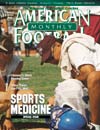AMERICAN FOOTBALL MONTHLY THE #1 RESOURCE FOR FOOTBALL COACHES
Article CategoriesAFM Magazine
|
Shotgun QuickClemson\'s quick passing game out of the shotgunby: Rich Rodriquez Offensive Coordinator/ Assistant Head Coach, Clemson University © More from this issue As with any offensive system, several aspects must be executed with consistent precision in order to effectively move the ball and score points. One of the most important aspects we feel is crucial to our success is the quick passing game. Because we run about 80 percent of our offense out of the shotgun, we must be able to execute the quick game out of the gun as well. As everyone knows, you must have crisp timing in your execution of the quick passing game. We feel our timing is often better in the shotgun than it would be under center. We will still go under center on occasion, with the traditional quick 3-step drop (one big and two gather steps), but we prefer to be in the shotgu....The full article can only be seen by subscribers.
|
|
|||||||
| HOME |
MAGAZINE |
SUBSCRIBE | ONLINE COLUMNISTS | COACHING VIDEOS |
Copyright 2025, AmericanFootballMonthly.com
All Rights Reserved





